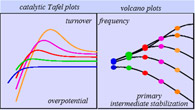Publication
826
ACS Appl. Mater. Interfaces, 9 (23), 19894-19899, 2017
DOI:10.1021/acsami.7b04349
|
|
|
|
|
|
 |
Heterogeneous Molecular Catalysis of Electrochemical Reactions: Volcano Plots and Catalytic Tafel Plots
|
|
|
|
Cyrille Costentin, and Jean-Michel Savéant
Université Paris Diderot, Sorbonne Paris Cité, Laboratoire d’Electrochimie Moléculaire, Unité Mixte de Recherche Université-CNRS 7591, Bâtiment Lavoisier, 15 Rue Jean de Baïf, 75205 Cedex 13, Paris, France
We analyze here, in the framework of heterogeneous molecular catalysis, the reasons for the occurrence or nonoccurrence of volcanoes upon plotting the kinetics of the catalytic reaction versus the stabilization free energy of the primary intermediate of the catalytic process. As in the case of homogeneous molecular catalysis or catalysis by surface-active metallic sites, a strong motivation of such studies relates to modern energy challenges, particularly those involving small molecules, such as water, hydrogen, oxygen, proton, and carbon dioxide. This motivation is particularly pertinent for what concerns heterogeneous molecular catalysis, since it is commonly preferred to homogeneous molecular catalysis by the same molecules if only for chemical separation purposes and electrolytic cell architecture. As with the two other catalysis modes, the main drawback of the volcano plot approach is the basic assumption that the kinetic responses depend on a single descriptor, viz., the stabilization free energy of the primary intermediate. More comprehensive approaches, investigating the responses to the maximal number of experimental factors, and conveniently expressed as catalytic Tafel plots, should clearly be preferred. This is more so in the case of heterogeneous molecular catalysis in that additional transport factors in the supporting film may additionally affect the current–potential responses. This is attested by the noteworthy presence of maxima in catalytic Tafel plots as well as their dependence upon the cyclic voltammetric scan rate. |

